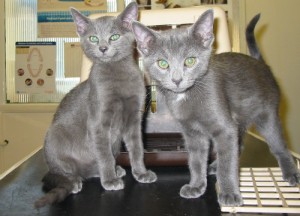Choosing your kitten can be difficult when presented with multiple cute little ones to pick from. Below are my top ten tips:
- Look for one with bright clean eyes, a clean nose and one that is lively. Runny eyes or frequent sneezing can be a sign of infection with cat flu viruses, which can be a persistent problem.
- If colour is an issue remember that tortoiseshell coloured domestic short hairs (“moggies”) which are always female, can be very feisty in nature.
- Sexing kittens can be tricky if you are not practiced at it. You may want to double check the sex yourself rather than just relying on the owner’s information, or have it checked by your local vet. When looking under the tail, there is always a bigger gap between the anal ring and penis, than there is between the anal ring and the vulva. It can help to look at a few kittens hopefully of different sex to see the difference.
- The kitten should be at least 6 weeks old and should be fully weaned and eating solid foods.
- Feel the belly to check for an umbilical hernia. This is a soft fatty swelling under the skin in the middle of the belly and occurs when the hole that the umbilical cord passes through does not close fully at birth. This can allow a small amount of fat to pass through from the abdomen, and if present may need surgical correction at a later date.
- Check the coat for fleas or flea droppings. Flea droppings may be easier to spot and look like specks of dirt in the coat, which if put on damp white tissue paper leave a red stain as they contain traces of blood. Very young kittens heavily infested with fleas can become anaemic, although in most cases a few fleas can be easily treated with a spot on treatment from your local vet.
- Check when the kitten was last wormed. Kittens should be wormed when weaned at about 4 weeks of age and then every 2 weeks until 10 weeks of age, often with a liquid wormer such as Panacur. All kittens will be born with some worms, and so will require treatment to eliminate them.
- Pedigree kittens can be at higher risk of genetic diseases, although most are usually perfectly healthy. Some cats may be screened before breeding, to reduce the risk of passing these diseases to the kittens. Current screening schemes include heart disease (hypertrophic cardiomyopathy is prevalent in maine coon and rag doll cats), or kidney disease (polycystic kidney disease is prevalent in persians and exotic shorthairs). Further information can be found here http://www.fabcats.org/breeders/registers.php
- You may want to see the mum and if possible the dad to give you an idea of temperament and size when adult, although there can be a great deal of variation even within a litter, especially of domestic short hairs (common “moggies”). This may be more useful with pedigree cats which have less variation.
- Check the hair coat of the kitten. Most cats are short haired, but some may be long haired (even in the same litter of “moggies”) and they may need more grooming and be more prone to developing matted fur.


0 Responses
Stay in touch with the conversation, subscribe to the RSS feed for comments on this post.